A Comparative Analysis: London Underground Customer Service Quality
VerifiedAdded on 2021/02/20
|38
|10354
|299
Report
AI Summary
This report provides a comprehensive analysis of the London Underground (LU) customer service, focusing on the comparison between the promised service quality and the actual experiences of passengers. It begins with an introduction that outlines the study's background, rationale, aims, objectives, research questions, and significance. The report then delves into a thorough literature review, examining existing research on London Underground services, expected features, and the gaps between the promised and actual customer service. The methodology section details the research approach, followed by data analysis to support the findings. The study aims to evaluate the customer service of London Underground by comparing the existing services with the expected models, identifying the operational gaps and limitations affecting passenger satisfaction. The report also discusses the significance of the study, highlighting the controversies surrounding the LU's operations, including ownership issues and financial losses. The report concludes with recommendations for improving LU services, based on the findings of the analysis, with the ultimate goal of enhancing customer satisfaction and the overall efficiency of the public transportation system. References and appendices are included to support the research.
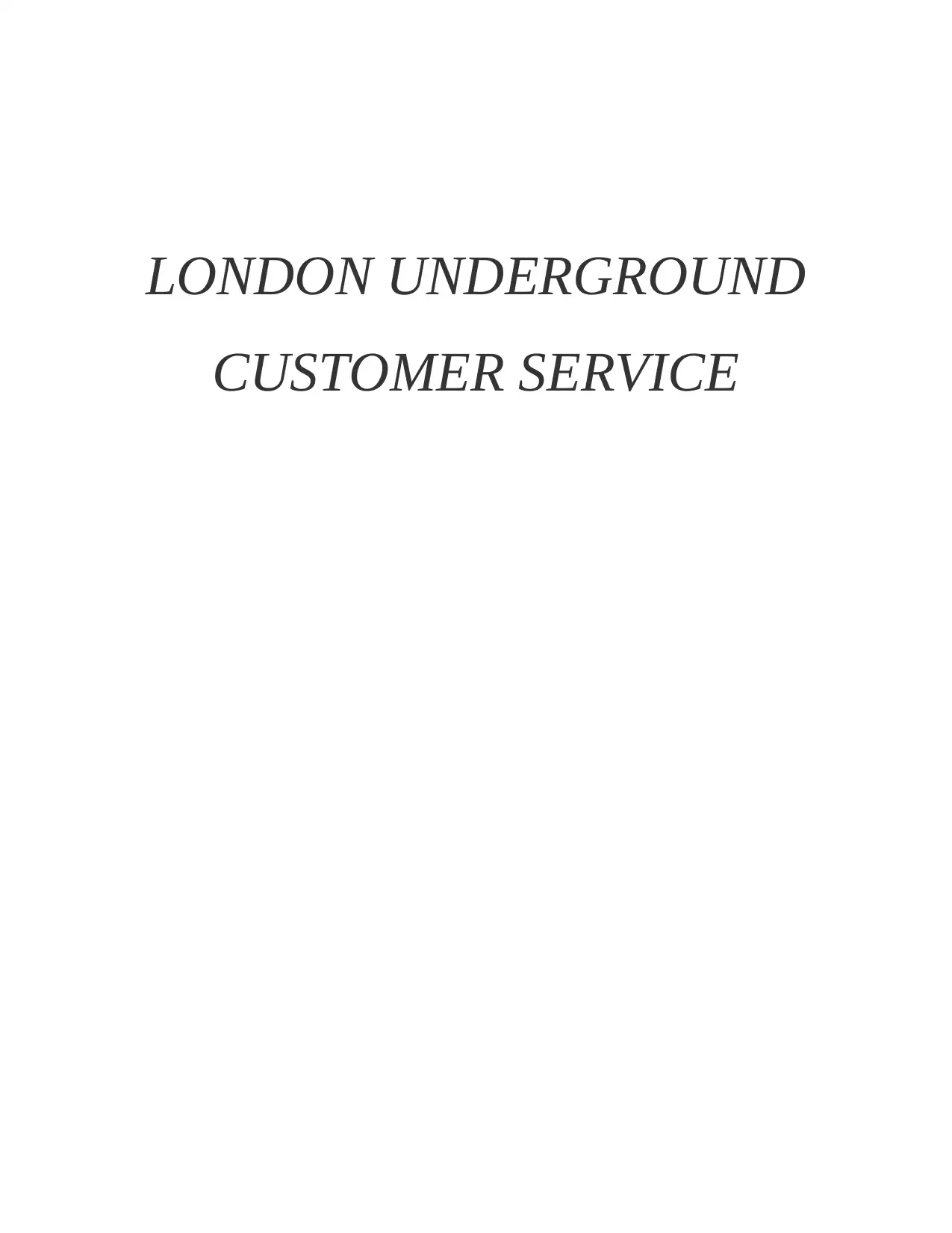
LONDON UNDERGROUND
CUSTOMER SERVICE
CUSTOMER SERVICE
Paraphrase This Document
Need a fresh take? Get an instant paraphrase of this document with our AI Paraphraser
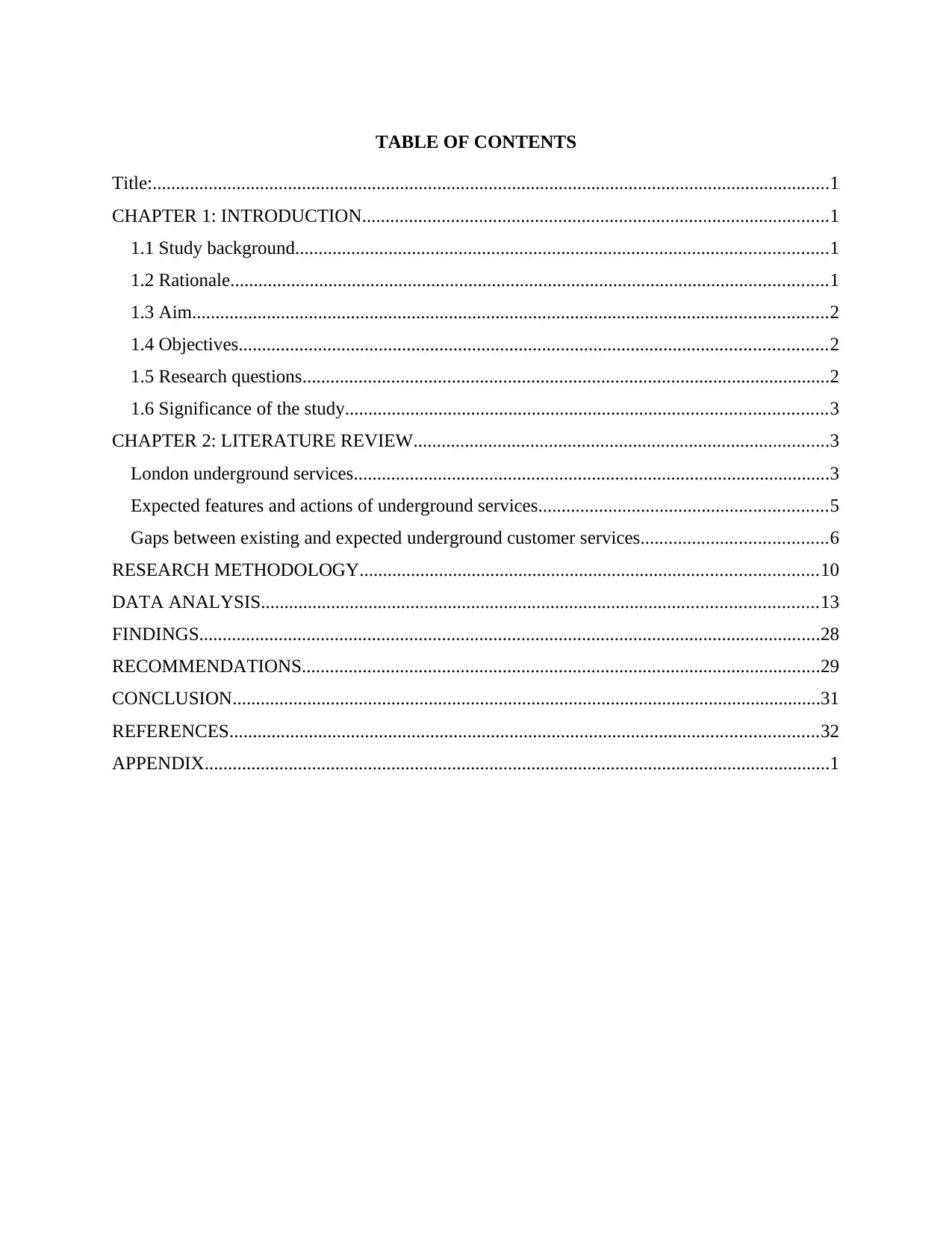
TABLE OF CONTENTS
Title:.................................................................................................................................................1
CHAPTER 1: INTRODUCTION....................................................................................................1
1.1 Study background..................................................................................................................1
1.2 Rationale................................................................................................................................1
1.3 Aim........................................................................................................................................2
1.4 Objectives..............................................................................................................................2
1.5 Research questions.................................................................................................................2
1.6 Significance of the study.......................................................................................................3
CHAPTER 2: LITERATURE REVIEW.........................................................................................3
London underground services......................................................................................................3
Expected features and actions of underground services..............................................................5
Gaps between existing and expected underground customer services........................................6
RESEARCH METHODOLOGY..................................................................................................10
DATA ANALYSIS.......................................................................................................................13
FINDINGS.....................................................................................................................................28
RECOMMENDATIONS...............................................................................................................29
CONCLUSION..............................................................................................................................31
REFERENCES..............................................................................................................................32
APPENDIX......................................................................................................................................1
Title:.................................................................................................................................................1
CHAPTER 1: INTRODUCTION....................................................................................................1
1.1 Study background..................................................................................................................1
1.2 Rationale................................................................................................................................1
1.3 Aim........................................................................................................................................2
1.4 Objectives..............................................................................................................................2
1.5 Research questions.................................................................................................................2
1.6 Significance of the study.......................................................................................................3
CHAPTER 2: LITERATURE REVIEW.........................................................................................3
London underground services......................................................................................................3
Expected features and actions of underground services..............................................................5
Gaps between existing and expected underground customer services........................................6
RESEARCH METHODOLOGY..................................................................................................10
DATA ANALYSIS.......................................................................................................................13
FINDINGS.....................................................................................................................................28
RECOMMENDATIONS...............................................................................................................29
CONCLUSION..............................................................................................................................31
REFERENCES..............................................................................................................................32
APPENDIX......................................................................................................................................1
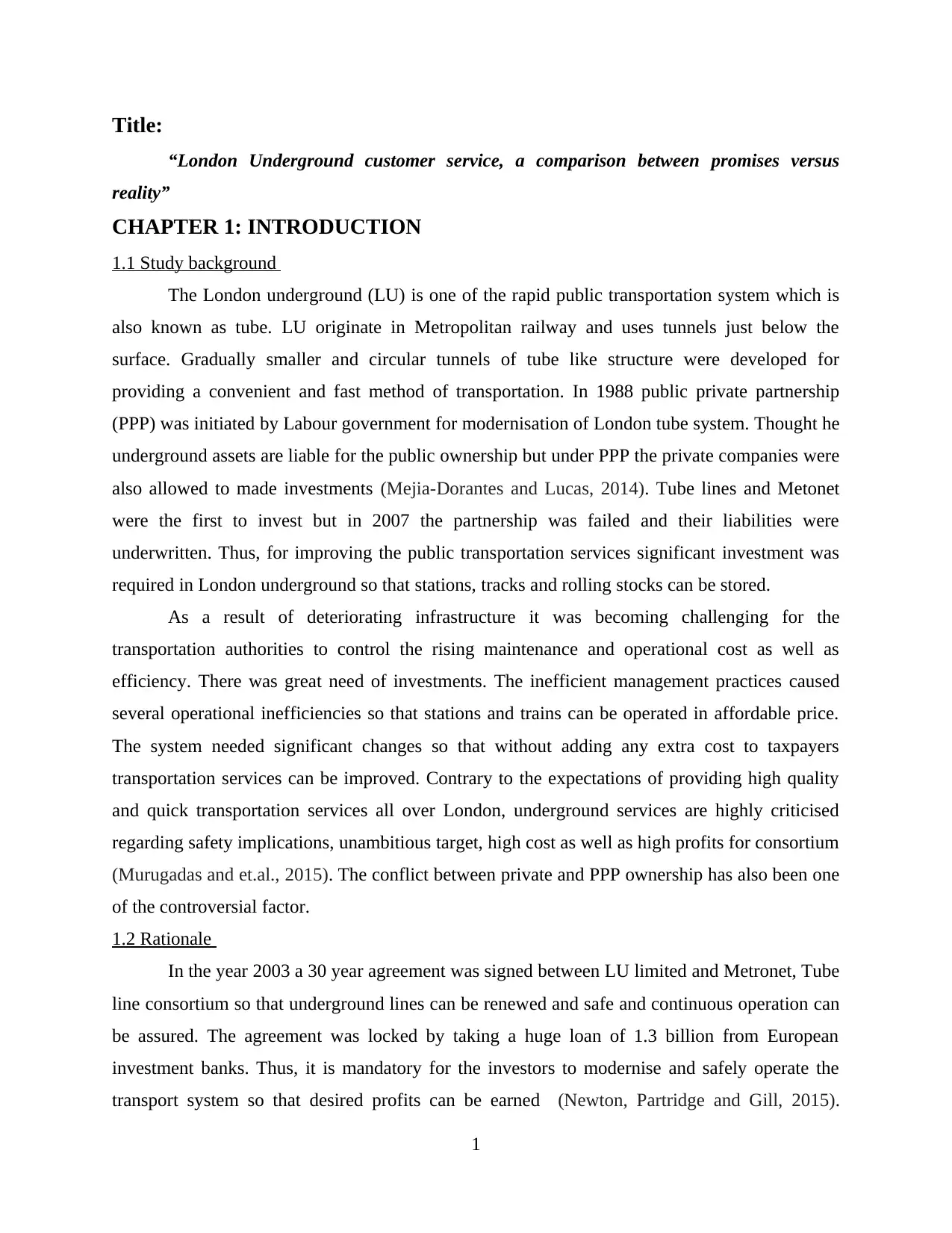
Title:
“London Underground customer service, a comparison between promises versus
reality”
CHAPTER 1: INTRODUCTION
1.1 Study background
The London underground (LU) is one of the rapid public transportation system which is
also known as tube. LU originate in Metropolitan railway and uses tunnels just below the
surface. Gradually smaller and circular tunnels of tube like structure were developed for
providing a convenient and fast method of transportation. In 1988 public private partnership
(PPP) was initiated by Labour government for modernisation of London tube system. Thought he
underground assets are liable for the public ownership but under PPP the private companies were
also allowed to made investments (Mejia-Dorantes and Lucas, 2014). Tube lines and Metonet
were the first to invest but in 2007 the partnership was failed and their liabilities were
underwritten. Thus, for improving the public transportation services significant investment was
required in London underground so that stations, tracks and rolling stocks can be stored.
As a result of deteriorating infrastructure it was becoming challenging for the
transportation authorities to control the rising maintenance and operational cost as well as
efficiency. There was great need of investments. The inefficient management practices caused
several operational inefficiencies so that stations and trains can be operated in affordable price.
The system needed significant changes so that without adding any extra cost to taxpayers
transportation services can be improved. Contrary to the expectations of providing high quality
and quick transportation services all over London, underground services are highly criticised
regarding safety implications, unambitious target, high cost as well as high profits for consortium
(Murugadas and et.al., 2015). The conflict between private and PPP ownership has also been one
of the controversial factor.
1.2 Rationale
In the year 2003 a 30 year agreement was signed between LU limited and Metronet, Tube
line consortium so that underground lines can be renewed and safe and continuous operation can
be assured. The agreement was locked by taking a huge loan of 1.3 billion from European
investment banks. Thus, it is mandatory for the investors to modernise and safely operate the
transport system so that desired profits can be earned (Newton, Partridge and Gill, 2015).
1
“London Underground customer service, a comparison between promises versus
reality”
CHAPTER 1: INTRODUCTION
1.1 Study background
The London underground (LU) is one of the rapid public transportation system which is
also known as tube. LU originate in Metropolitan railway and uses tunnels just below the
surface. Gradually smaller and circular tunnels of tube like structure were developed for
providing a convenient and fast method of transportation. In 1988 public private partnership
(PPP) was initiated by Labour government for modernisation of London tube system. Thought he
underground assets are liable for the public ownership but under PPP the private companies were
also allowed to made investments (Mejia-Dorantes and Lucas, 2014). Tube lines and Metonet
were the first to invest but in 2007 the partnership was failed and their liabilities were
underwritten. Thus, for improving the public transportation services significant investment was
required in London underground so that stations, tracks and rolling stocks can be stored.
As a result of deteriorating infrastructure it was becoming challenging for the
transportation authorities to control the rising maintenance and operational cost as well as
efficiency. There was great need of investments. The inefficient management practices caused
several operational inefficiencies so that stations and trains can be operated in affordable price.
The system needed significant changes so that without adding any extra cost to taxpayers
transportation services can be improved. Contrary to the expectations of providing high quality
and quick transportation services all over London, underground services are highly criticised
regarding safety implications, unambitious target, high cost as well as high profits for consortium
(Murugadas and et.al., 2015). The conflict between private and PPP ownership has also been one
of the controversial factor.
1.2 Rationale
In the year 2003 a 30 year agreement was signed between LU limited and Metronet, Tube
line consortium so that underground lines can be renewed and safe and continuous operation can
be assured. The agreement was locked by taking a huge loan of 1.3 billion from European
investment banks. Thus, it is mandatory for the investors to modernise and safely operate the
transport system so that desired profits can be earned (Newton, Partridge and Gill, 2015).
1
⊘ This is a preview!⊘
Do you want full access?
Subscribe today to unlock all pages.

Trusted by 1+ million students worldwide
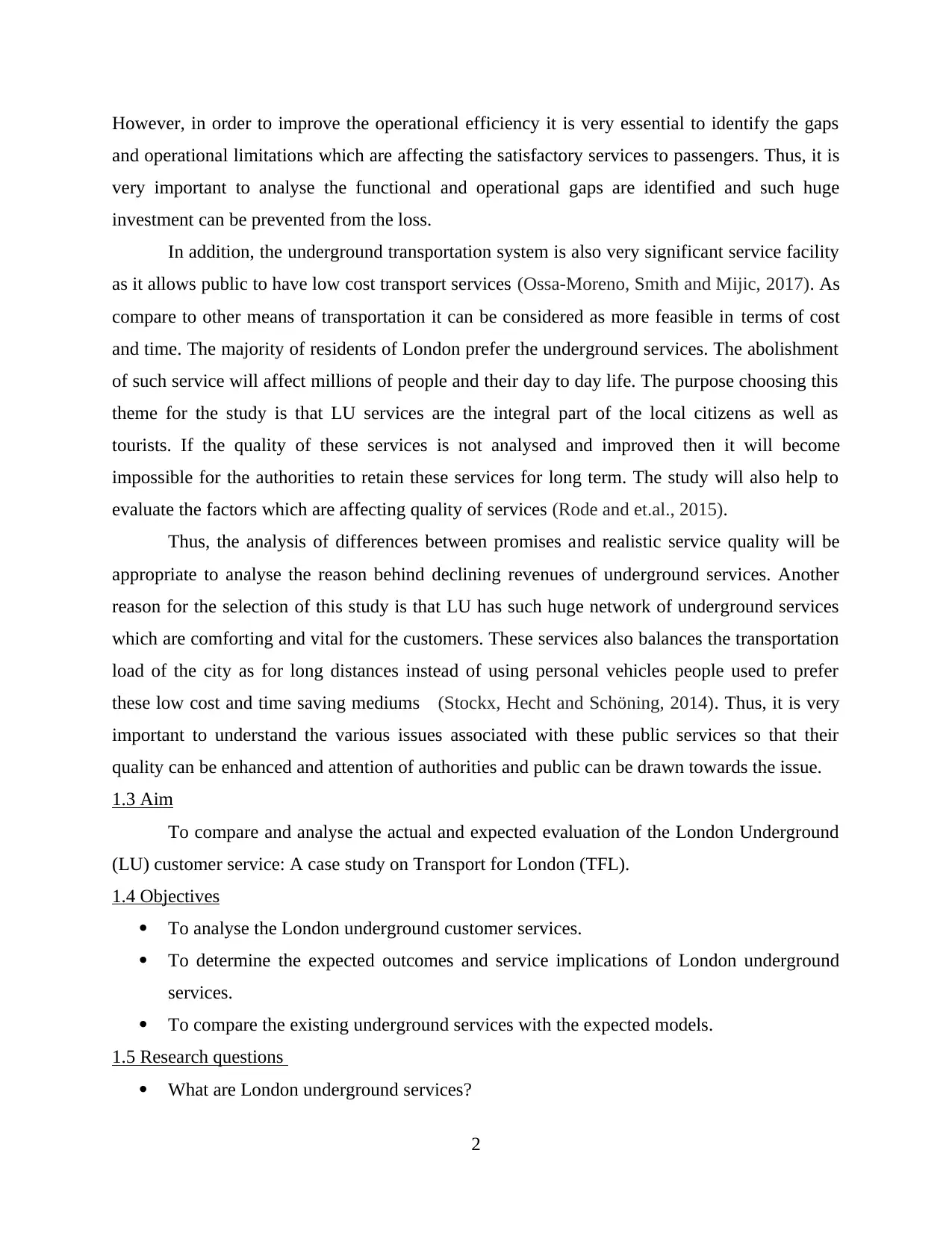
However, in order to improve the operational efficiency it is very essential to identify the gaps
and operational limitations which are affecting the satisfactory services to passengers. Thus, it is
very important to analyse the functional and operational gaps are identified and such huge
investment can be prevented from the loss.
In addition, the underground transportation system is also very significant service facility
as it allows public to have low cost transport services (Ossa-Moreno, Smith and Mijic, 2017). As
compare to other means of transportation it can be considered as more feasible in terms of cost
and time. The majority of residents of London prefer the underground services. The abolishment
of such service will affect millions of people and their day to day life. The purpose choosing this
theme for the study is that LU services are the integral part of the local citizens as well as
tourists. If the quality of these services is not analysed and improved then it will become
impossible for the authorities to retain these services for long term. The study will also help to
evaluate the factors which are affecting quality of services (Rode and et.al., 2015).
Thus, the analysis of differences between promises and realistic service quality will be
appropriate to analyse the reason behind declining revenues of underground services. Another
reason for the selection of this study is that LU has such huge network of underground services
which are comforting and vital for the customers. These services also balances the transportation
load of the city as for long distances instead of using personal vehicles people used to prefer
these low cost and time saving mediums (Stockx, Hecht and Schöning, 2014). Thus, it is very
important to understand the various issues associated with these public services so that their
quality can be enhanced and attention of authorities and public can be drawn towards the issue.
1.3 Aim
To compare and analyse the actual and expected evaluation of the London Underground
(LU) customer service: A case study on Transport for London (TFL).
1.4 Objectives
To analyse the London underground customer services.
To determine the expected outcomes and service implications of London underground
services.
To compare the existing underground services with the expected models.
1.5 Research questions
What are London underground services?
2
and operational limitations which are affecting the satisfactory services to passengers. Thus, it is
very important to analyse the functional and operational gaps are identified and such huge
investment can be prevented from the loss.
In addition, the underground transportation system is also very significant service facility
as it allows public to have low cost transport services (Ossa-Moreno, Smith and Mijic, 2017). As
compare to other means of transportation it can be considered as more feasible in terms of cost
and time. The majority of residents of London prefer the underground services. The abolishment
of such service will affect millions of people and their day to day life. The purpose choosing this
theme for the study is that LU services are the integral part of the local citizens as well as
tourists. If the quality of these services is not analysed and improved then it will become
impossible for the authorities to retain these services for long term. The study will also help to
evaluate the factors which are affecting quality of services (Rode and et.al., 2015).
Thus, the analysis of differences between promises and realistic service quality will be
appropriate to analyse the reason behind declining revenues of underground services. Another
reason for the selection of this study is that LU has such huge network of underground services
which are comforting and vital for the customers. These services also balances the transportation
load of the city as for long distances instead of using personal vehicles people used to prefer
these low cost and time saving mediums (Stockx, Hecht and Schöning, 2014). Thus, it is very
important to understand the various issues associated with these public services so that their
quality can be enhanced and attention of authorities and public can be drawn towards the issue.
1.3 Aim
To compare and analyse the actual and expected evaluation of the London Underground
(LU) customer service: A case study on Transport for London (TFL).
1.4 Objectives
To analyse the London underground customer services.
To determine the expected outcomes and service implications of London underground
services.
To compare the existing underground services with the expected models.
1.5 Research questions
What are London underground services?
2
Paraphrase This Document
Need a fresh take? Get an instant paraphrase of this document with our AI Paraphraser
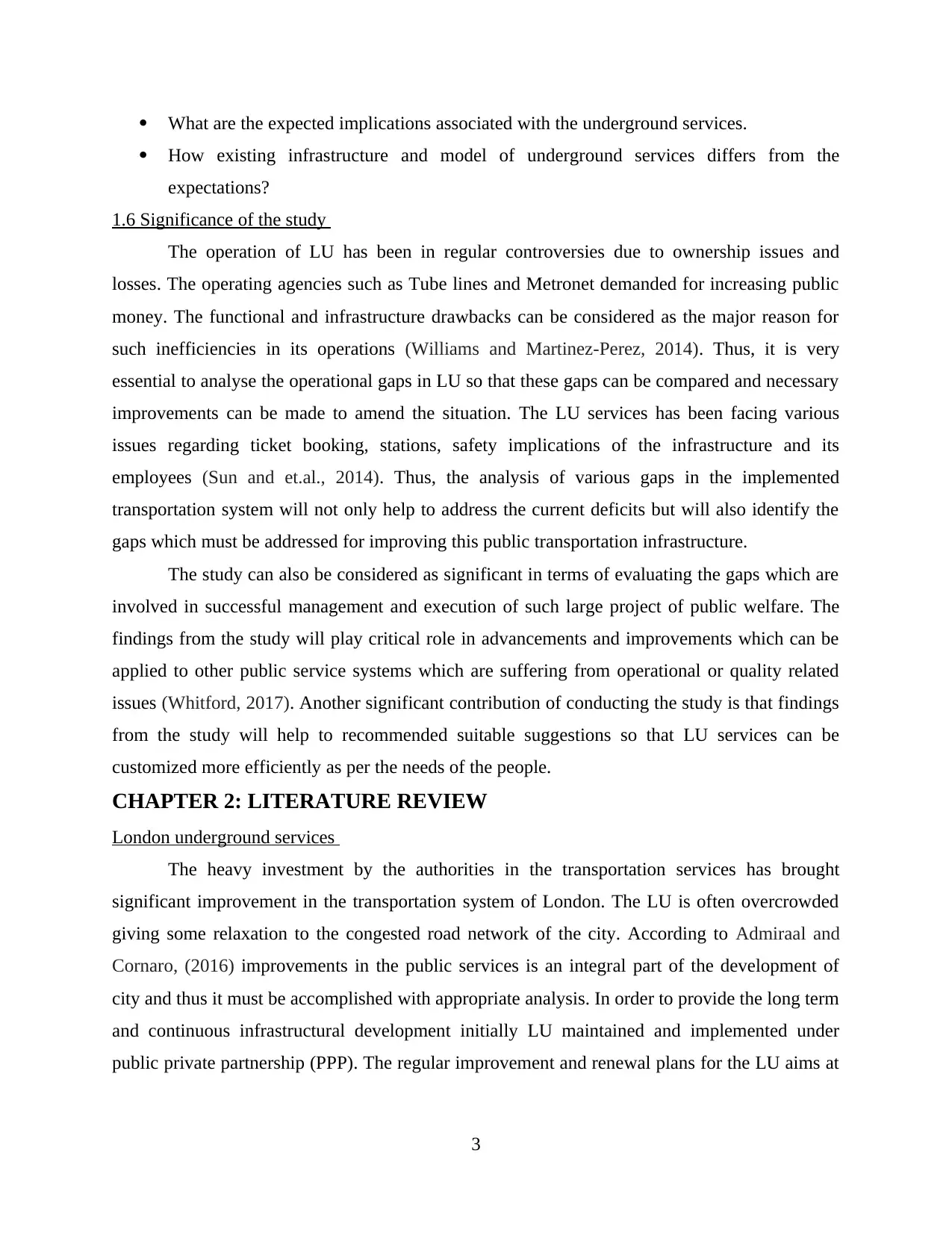
What are the expected implications associated with the underground services.
How existing infrastructure and model of underground services differs from the
expectations?
1.6 Significance of the study
The operation of LU has been in regular controversies due to ownership issues and
losses. The operating agencies such as Tube lines and Metronet demanded for increasing public
money. The functional and infrastructure drawbacks can be considered as the major reason for
such inefficiencies in its operations (Williams and Martinez-Perez, 2014). Thus, it is very
essential to analyse the operational gaps in LU so that these gaps can be compared and necessary
improvements can be made to amend the situation. The LU services has been facing various
issues regarding ticket booking, stations, safety implications of the infrastructure and its
employees (Sun and et.al., 2014). Thus, the analysis of various gaps in the implemented
transportation system will not only help to address the current deficits but will also identify the
gaps which must be addressed for improving this public transportation infrastructure.
The study can also be considered as significant in terms of evaluating the gaps which are
involved in successful management and execution of such large project of public welfare. The
findings from the study will play critical role in advancements and improvements which can be
applied to other public service systems which are suffering from operational or quality related
issues (Whitford, 2017). Another significant contribution of conducting the study is that findings
from the study will help to recommended suitable suggestions so that LU services can be
customized more efficiently as per the needs of the people.
CHAPTER 2: LITERATURE REVIEW
London underground services
The heavy investment by the authorities in the transportation services has brought
significant improvement in the transportation system of London. The LU is often overcrowded
giving some relaxation to the congested road network of the city. According to Admiraal and
Cornaro, (2016) improvements in the public services is an integral part of the development of
city and thus it must be accomplished with appropriate analysis. In order to provide the long term
and continuous infrastructural development initially LU maintained and implemented under
public private partnership (PPP). The regular improvement and renewal plans for the LU aims at
3
How existing infrastructure and model of underground services differs from the
expectations?
1.6 Significance of the study
The operation of LU has been in regular controversies due to ownership issues and
losses. The operating agencies such as Tube lines and Metronet demanded for increasing public
money. The functional and infrastructure drawbacks can be considered as the major reason for
such inefficiencies in its operations (Williams and Martinez-Perez, 2014). Thus, it is very
essential to analyse the operational gaps in LU so that these gaps can be compared and necessary
improvements can be made to amend the situation. The LU services has been facing various
issues regarding ticket booking, stations, safety implications of the infrastructure and its
employees (Sun and et.al., 2014). Thus, the analysis of various gaps in the implemented
transportation system will not only help to address the current deficits but will also identify the
gaps which must be addressed for improving this public transportation infrastructure.
The study can also be considered as significant in terms of evaluating the gaps which are
involved in successful management and execution of such large project of public welfare. The
findings from the study will play critical role in advancements and improvements which can be
applied to other public service systems which are suffering from operational or quality related
issues (Whitford, 2017). Another significant contribution of conducting the study is that findings
from the study will help to recommended suitable suggestions so that LU services can be
customized more efficiently as per the needs of the people.
CHAPTER 2: LITERATURE REVIEW
London underground services
The heavy investment by the authorities in the transportation services has brought
significant improvement in the transportation system of London. The LU is often overcrowded
giving some relaxation to the congested road network of the city. According to Admiraal and
Cornaro, (2016) improvements in the public services is an integral part of the development of
city and thus it must be accomplished with appropriate analysis. In order to provide the long term
and continuous infrastructural development initially LU maintained and implemented under
public private partnership (PPP). The regular improvement and renewal plans for the LU aims at
3
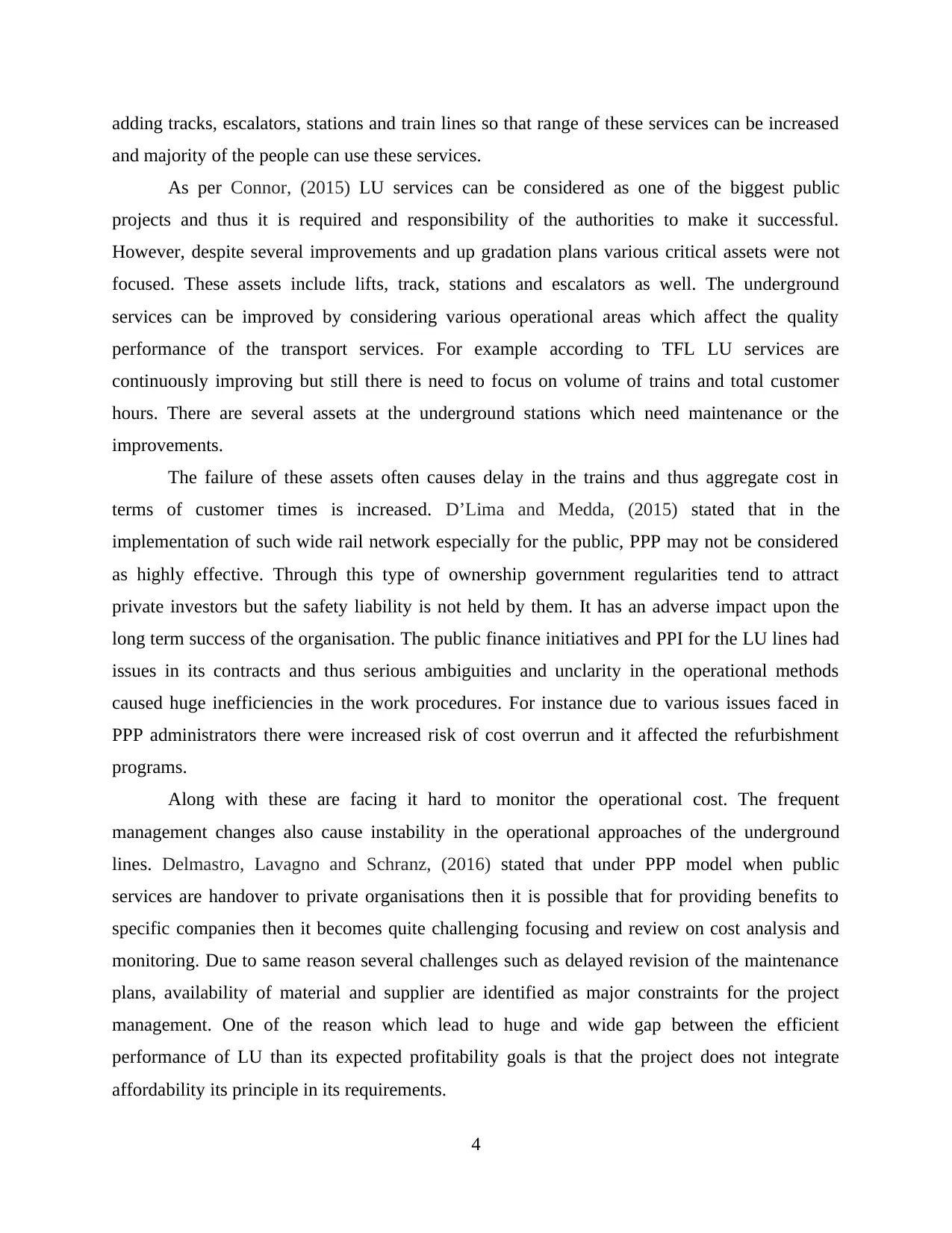
adding tracks, escalators, stations and train lines so that range of these services can be increased
and majority of the people can use these services.
As per Connor, (2015) LU services can be considered as one of the biggest public
projects and thus it is required and responsibility of the authorities to make it successful.
However, despite several improvements and up gradation plans various critical assets were not
focused. These assets include lifts, track, stations and escalators as well. The underground
services can be improved by considering various operational areas which affect the quality
performance of the transport services. For example according to TFL LU services are
continuously improving but still there is need to focus on volume of trains and total customer
hours. There are several assets at the underground stations which need maintenance or the
improvements.
The failure of these assets often causes delay in the trains and thus aggregate cost in
terms of customer times is increased. D’Lima and Medda, (2015) stated that in the
implementation of such wide rail network especially for the public, PPP may not be considered
as highly effective. Through this type of ownership government regularities tend to attract
private investors but the safety liability is not held by them. It has an adverse impact upon the
long term success of the organisation. The public finance initiatives and PPI for the LU lines had
issues in its contracts and thus serious ambiguities and unclarity in the operational methods
caused huge inefficiencies in the work procedures. For instance due to various issues faced in
PPP administrators there were increased risk of cost overrun and it affected the refurbishment
programs.
Along with these are facing it hard to monitor the operational cost. The frequent
management changes also cause instability in the operational approaches of the underground
lines. Delmastro, Lavagno and Schranz, (2016) stated that under PPP model when public
services are handover to private organisations then it is possible that for providing benefits to
specific companies then it becomes quite challenging focusing and review on cost analysis and
monitoring. Due to same reason several challenges such as delayed revision of the maintenance
plans, availability of material and supplier are identified as major constraints for the project
management. One of the reason which lead to huge and wide gap between the efficient
performance of LU than its expected profitability goals is that the project does not integrate
affordability its principle in its requirements.
4
and majority of the people can use these services.
As per Connor, (2015) LU services can be considered as one of the biggest public
projects and thus it is required and responsibility of the authorities to make it successful.
However, despite several improvements and up gradation plans various critical assets were not
focused. These assets include lifts, track, stations and escalators as well. The underground
services can be improved by considering various operational areas which affect the quality
performance of the transport services. For example according to TFL LU services are
continuously improving but still there is need to focus on volume of trains and total customer
hours. There are several assets at the underground stations which need maintenance or the
improvements.
The failure of these assets often causes delay in the trains and thus aggregate cost in
terms of customer times is increased. D’Lima and Medda, (2015) stated that in the
implementation of such wide rail network especially for the public, PPP may not be considered
as highly effective. Through this type of ownership government regularities tend to attract
private investors but the safety liability is not held by them. It has an adverse impact upon the
long term success of the organisation. The public finance initiatives and PPI for the LU lines had
issues in its contracts and thus serious ambiguities and unclarity in the operational methods
caused huge inefficiencies in the work procedures. For instance due to various issues faced in
PPP administrators there were increased risk of cost overrun and it affected the refurbishment
programs.
Along with these are facing it hard to monitor the operational cost. The frequent
management changes also cause instability in the operational approaches of the underground
lines. Delmastro, Lavagno and Schranz, (2016) stated that under PPP model when public
services are handover to private organisations then it is possible that for providing benefits to
specific companies then it becomes quite challenging focusing and review on cost analysis and
monitoring. Due to same reason several challenges such as delayed revision of the maintenance
plans, availability of material and supplier are identified as major constraints for the project
management. One of the reason which lead to huge and wide gap between the efficient
performance of LU than its expected profitability goals is that the project does not integrate
affordability its principle in its requirements.
4
⊘ This is a preview!⊘
Do you want full access?
Subscribe today to unlock all pages.

Trusted by 1+ million students worldwide
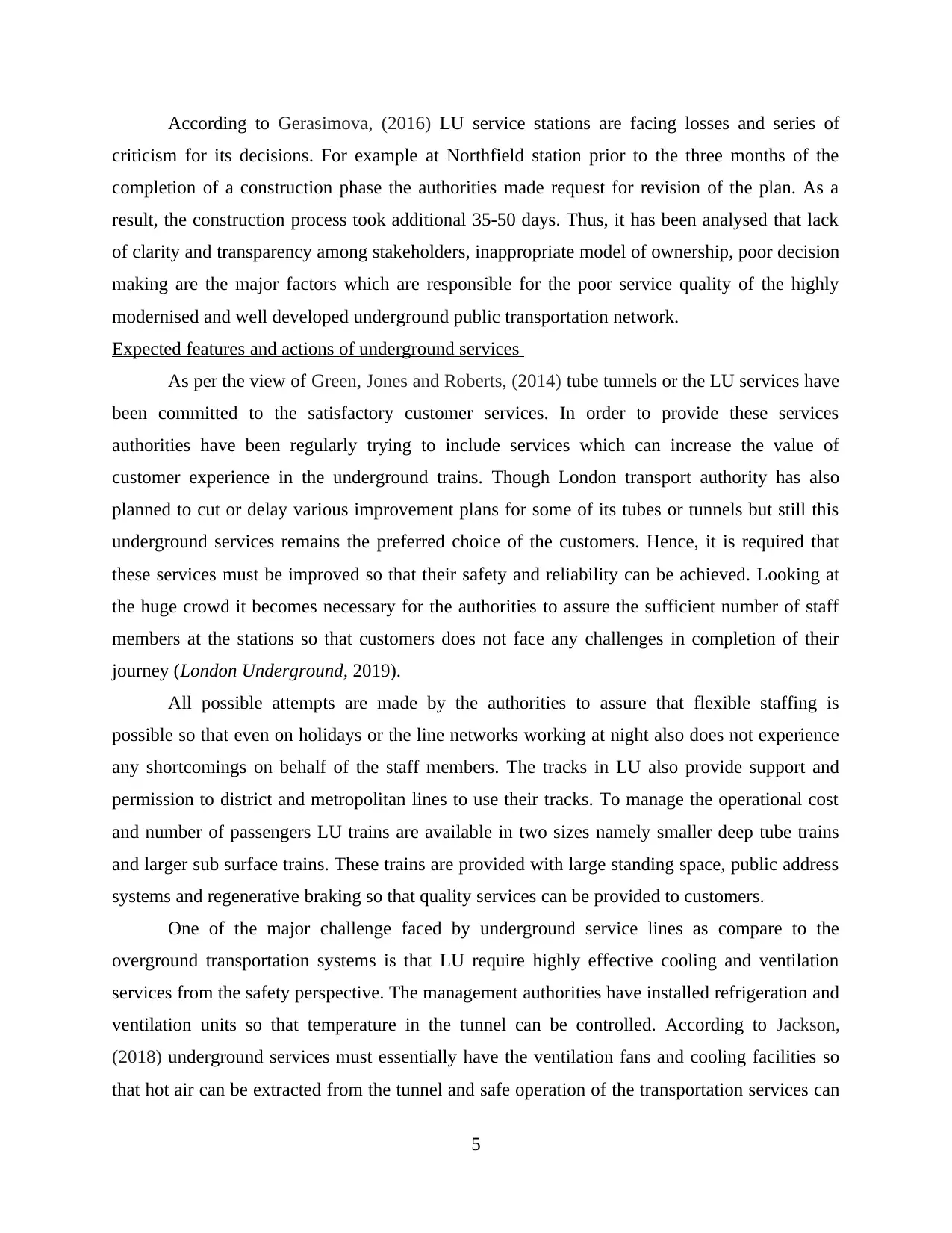
According to Gerasimova, (2016) LU service stations are facing losses and series of
criticism for its decisions. For example at Northfield station prior to the three months of the
completion of a construction phase the authorities made request for revision of the plan. As a
result, the construction process took additional 35-50 days. Thus, it has been analysed that lack
of clarity and transparency among stakeholders, inappropriate model of ownership, poor decision
making are the major factors which are responsible for the poor service quality of the highly
modernised and well developed underground public transportation network.
Expected features and actions of underground services
As per the view of Green, Jones and Roberts, (2014) tube tunnels or the LU services have
been committed to the satisfactory customer services. In order to provide these services
authorities have been regularly trying to include services which can increase the value of
customer experience in the underground trains. Though London transport authority has also
planned to cut or delay various improvement plans for some of its tubes or tunnels but still this
underground services remains the preferred choice of the customers. Hence, it is required that
these services must be improved so that their safety and reliability can be achieved. Looking at
the huge crowd it becomes necessary for the authorities to assure the sufficient number of staff
members at the stations so that customers does not face any challenges in completion of their
journey (London Underground, 2019).
All possible attempts are made by the authorities to assure that flexible staffing is
possible so that even on holidays or the line networks working at night also does not experience
any shortcomings on behalf of the staff members. The tracks in LU also provide support and
permission to district and metropolitan lines to use their tracks. To manage the operational cost
and number of passengers LU trains are available in two sizes namely smaller deep tube trains
and larger sub surface trains. These trains are provided with large standing space, public address
systems and regenerative braking so that quality services can be provided to customers.
One of the major challenge faced by underground service lines as compare to the
overground transportation systems is that LU require highly effective cooling and ventilation
services from the safety perspective. The management authorities have installed refrigeration and
ventilation units so that temperature in the tunnel can be controlled. According to Jackson,
(2018) underground services must essentially have the ventilation fans and cooling facilities so
that hot air can be extracted from the tunnel and safe operation of the transportation services can
5
criticism for its decisions. For example at Northfield station prior to the three months of the
completion of a construction phase the authorities made request for revision of the plan. As a
result, the construction process took additional 35-50 days. Thus, it has been analysed that lack
of clarity and transparency among stakeholders, inappropriate model of ownership, poor decision
making are the major factors which are responsible for the poor service quality of the highly
modernised and well developed underground public transportation network.
Expected features and actions of underground services
As per the view of Green, Jones and Roberts, (2014) tube tunnels or the LU services have
been committed to the satisfactory customer services. In order to provide these services
authorities have been regularly trying to include services which can increase the value of
customer experience in the underground trains. Though London transport authority has also
planned to cut or delay various improvement plans for some of its tubes or tunnels but still this
underground services remains the preferred choice of the customers. Hence, it is required that
these services must be improved so that their safety and reliability can be achieved. Looking at
the huge crowd it becomes necessary for the authorities to assure the sufficient number of staff
members at the stations so that customers does not face any challenges in completion of their
journey (London Underground, 2019).
All possible attempts are made by the authorities to assure that flexible staffing is
possible so that even on holidays or the line networks working at night also does not experience
any shortcomings on behalf of the staff members. The tracks in LU also provide support and
permission to district and metropolitan lines to use their tracks. To manage the operational cost
and number of passengers LU trains are available in two sizes namely smaller deep tube trains
and larger sub surface trains. These trains are provided with large standing space, public address
systems and regenerative braking so that quality services can be provided to customers.
One of the major challenge faced by underground service lines as compare to the
overground transportation systems is that LU require highly effective cooling and ventilation
services from the safety perspective. The management authorities have installed refrigeration and
ventilation units so that temperature in the tunnel can be controlled. According to Jackson,
(2018) underground services must essentially have the ventilation fans and cooling facilities so
that hot air can be extracted from the tunnel and safe operation of the transportation services can
5
Paraphrase This Document
Need a fresh take? Get an instant paraphrase of this document with our AI Paraphraser
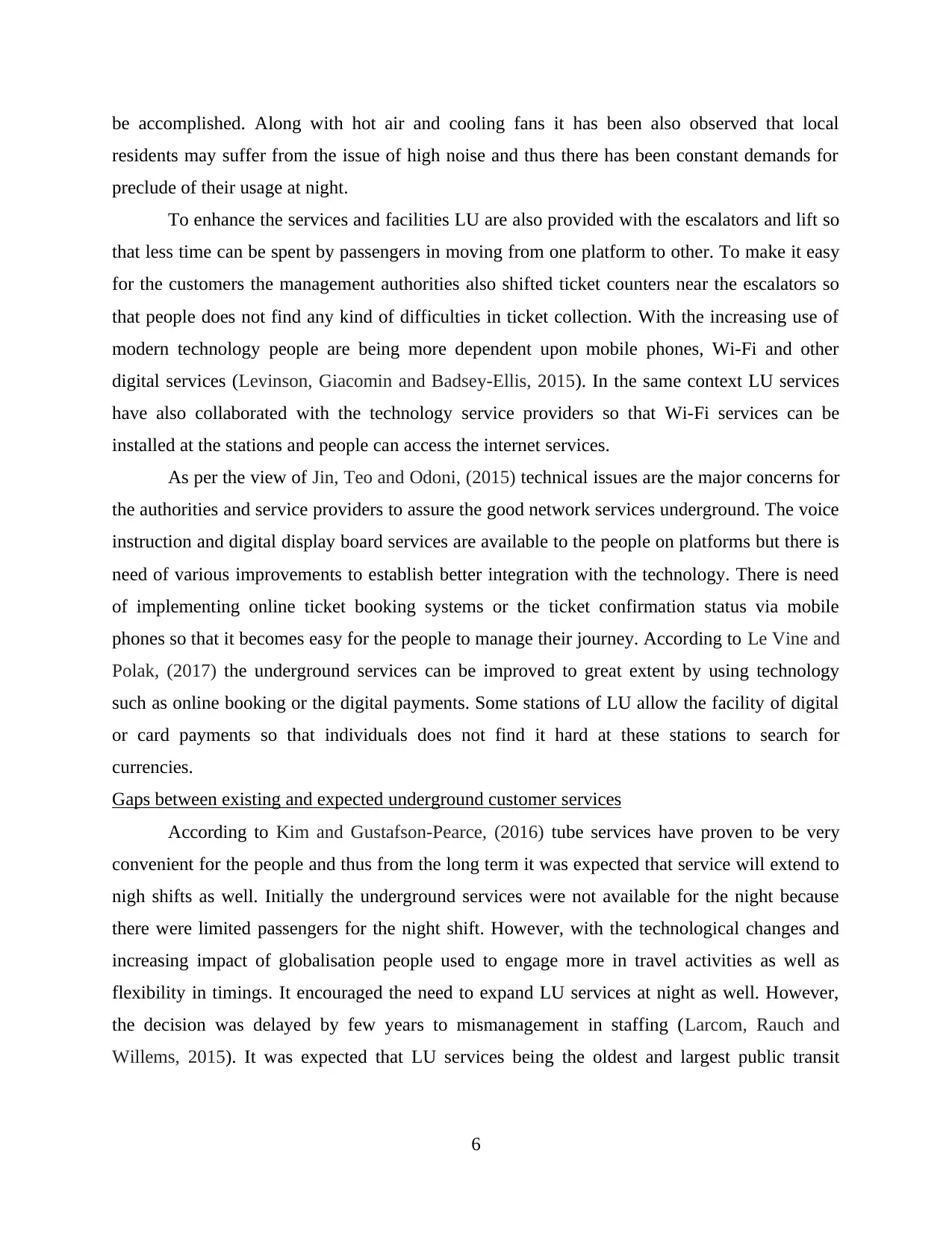
be accomplished. Along with hot air and cooling fans it has been also observed that local
residents may suffer from the issue of high noise and thus there has been constant demands for
preclude of their usage at night.
To enhance the services and facilities LU are also provided with the escalators and lift so
that less time can be spent by passengers in moving from one platform to other. To make it easy
for the customers the management authorities also shifted ticket counters near the escalators so
that people does not find any kind of difficulties in ticket collection. With the increasing use of
modern technology people are being more dependent upon mobile phones, Wi-Fi and other
digital services (Levinson, Giacomin and Badsey-Ellis, 2015). In the same context LU services
have also collaborated with the technology service providers so that Wi-Fi services can be
installed at the stations and people can access the internet services.
As per the view of Jin, Teo and Odoni, (2015) technical issues are the major concerns for
the authorities and service providers to assure the good network services underground. The voice
instruction and digital display board services are available to the people on platforms but there is
need of various improvements to establish better integration with the technology. There is need
of implementing online ticket booking systems or the ticket confirmation status via mobile
phones so that it becomes easy for the people to manage their journey. According to Le Vine and
Polak, (2017) the underground services can be improved to great extent by using technology
such as online booking or the digital payments. Some stations of LU allow the facility of digital
or card payments so that individuals does not find it hard at these stations to search for
currencies.
Gaps between existing and expected underground customer services
According to Kim and Gustafson-Pearce, (2016) tube services have proven to be very
convenient for the people and thus from the long term it was expected that service will extend to
nigh shifts as well. Initially the underground services were not available for the night because
there were limited passengers for the night shift. However, with the technological changes and
increasing impact of globalisation people used to engage more in travel activities as well as
flexibility in timings. It encouraged the need to expand LU services at night as well. However,
the decision was delayed by few years to mismanagement in staffing (Larcom, Rauch and
Willems, 2015). It was expected that LU services being the oldest and largest public transit
6
residents may suffer from the issue of high noise and thus there has been constant demands for
preclude of their usage at night.
To enhance the services and facilities LU are also provided with the escalators and lift so
that less time can be spent by passengers in moving from one platform to other. To make it easy
for the customers the management authorities also shifted ticket counters near the escalators so
that people does not find any kind of difficulties in ticket collection. With the increasing use of
modern technology people are being more dependent upon mobile phones, Wi-Fi and other
digital services (Levinson, Giacomin and Badsey-Ellis, 2015). In the same context LU services
have also collaborated with the technology service providers so that Wi-Fi services can be
installed at the stations and people can access the internet services.
As per the view of Jin, Teo and Odoni, (2015) technical issues are the major concerns for
the authorities and service providers to assure the good network services underground. The voice
instruction and digital display board services are available to the people on platforms but there is
need of various improvements to establish better integration with the technology. There is need
of implementing online ticket booking systems or the ticket confirmation status via mobile
phones so that it becomes easy for the people to manage their journey. According to Le Vine and
Polak, (2017) the underground services can be improved to great extent by using technology
such as online booking or the digital payments. Some stations of LU allow the facility of digital
or card payments so that individuals does not find it hard at these stations to search for
currencies.
Gaps between existing and expected underground customer services
According to Kim and Gustafson-Pearce, (2016) tube services have proven to be very
convenient for the people and thus from the long term it was expected that service will extend to
nigh shifts as well. Initially the underground services were not available for the night because
there were limited passengers for the night shift. However, with the technological changes and
increasing impact of globalisation people used to engage more in travel activities as well as
flexibility in timings. It encouraged the need to expand LU services at night as well. However,
the decision was delayed by few years to mismanagement in staffing (Larcom, Rauch and
Willems, 2015). It was expected that LU services being the oldest and largest public transit
6
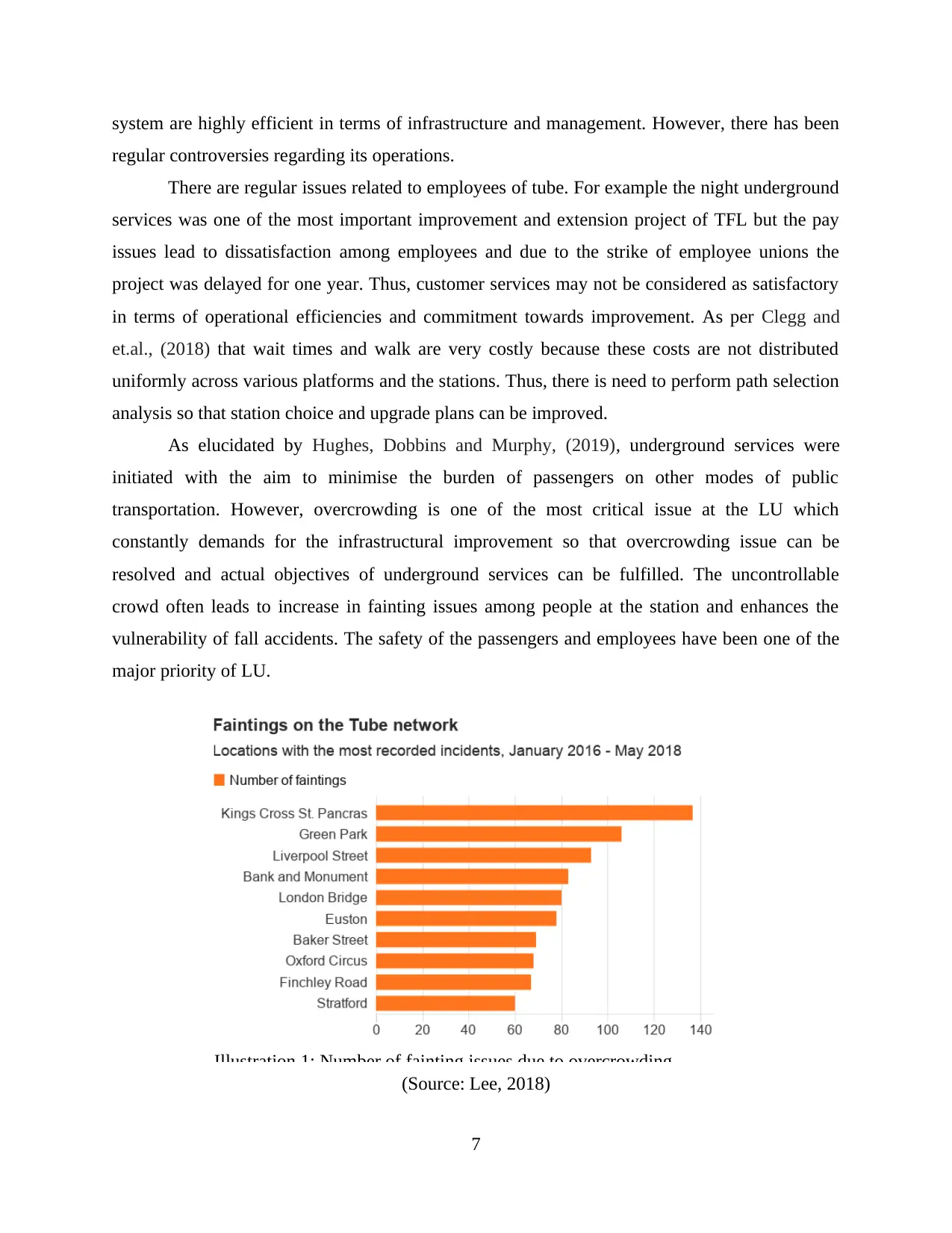
system are highly efficient in terms of infrastructure and management. However, there has been
regular controversies regarding its operations.
There are regular issues related to employees of tube. For example the night underground
services was one of the most important improvement and extension project of TFL but the pay
issues lead to dissatisfaction among employees and due to the strike of employee unions the
project was delayed for one year. Thus, customer services may not be considered as satisfactory
in terms of operational efficiencies and commitment towards improvement. As per Clegg and
et.al., (2018) that wait times and walk are very costly because these costs are not distributed
uniformly across various platforms and the stations. Thus, there is need to perform path selection
analysis so that station choice and upgrade plans can be improved.
As elucidated by Hughes, Dobbins and Murphy, (2019), underground services were
initiated with the aim to minimise the burden of passengers on other modes of public
transportation. However, overcrowding is one of the most critical issue at the LU which
constantly demands for the infrastructural improvement so that overcrowding issue can be
resolved and actual objectives of underground services can be fulfilled. The uncontrollable
crowd often leads to increase in fainting issues among people at the station and enhances the
vulnerability of fall accidents. The safety of the passengers and employees have been one of the
major priority of LU.
(Source: Lee, 2018)
7
Illustration 1: Number of fainting issues due to overcrowding
regular controversies regarding its operations.
There are regular issues related to employees of tube. For example the night underground
services was one of the most important improvement and extension project of TFL but the pay
issues lead to dissatisfaction among employees and due to the strike of employee unions the
project was delayed for one year. Thus, customer services may not be considered as satisfactory
in terms of operational efficiencies and commitment towards improvement. As per Clegg and
et.al., (2018) that wait times and walk are very costly because these costs are not distributed
uniformly across various platforms and the stations. Thus, there is need to perform path selection
analysis so that station choice and upgrade plans can be improved.
As elucidated by Hughes, Dobbins and Murphy, (2019), underground services were
initiated with the aim to minimise the burden of passengers on other modes of public
transportation. However, overcrowding is one of the most critical issue at the LU which
constantly demands for the infrastructural improvement so that overcrowding issue can be
resolved and actual objectives of underground services can be fulfilled. The uncontrollable
crowd often leads to increase in fainting issues among people at the station and enhances the
vulnerability of fall accidents. The safety of the passengers and employees have been one of the
major priority of LU.
(Source: Lee, 2018)
7
Illustration 1: Number of fainting issues due to overcrowding
⊘ This is a preview!⊘
Do you want full access?
Subscribe today to unlock all pages.

Trusted by 1+ million students worldwide
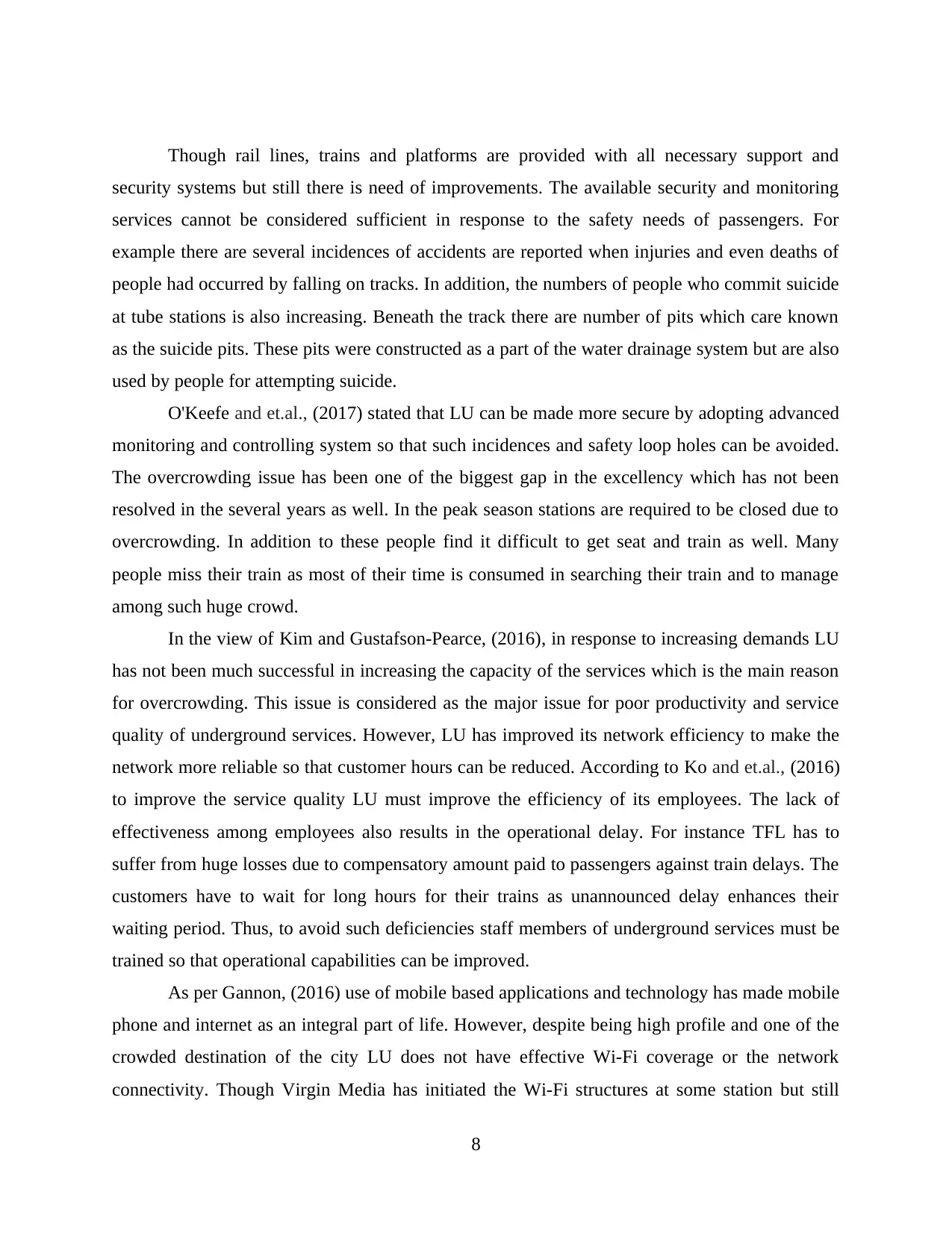
Though rail lines, trains and platforms are provided with all necessary support and
security systems but still there is need of improvements. The available security and monitoring
services cannot be considered sufficient in response to the safety needs of passengers. For
example there are several incidences of accidents are reported when injuries and even deaths of
people had occurred by falling on tracks. In addition, the numbers of people who commit suicide
at tube stations is also increasing. Beneath the track there are number of pits which care known
as the suicide pits. These pits were constructed as a part of the water drainage system but are also
used by people for attempting suicide.
O'Keefe and et.al., (2017) stated that LU can be made more secure by adopting advanced
monitoring and controlling system so that such incidences and safety loop holes can be avoided.
The overcrowding issue has been one of the biggest gap in the excellency which has not been
resolved in the several years as well. In the peak season stations are required to be closed due to
overcrowding. In addition to these people find it difficult to get seat and train as well. Many
people miss their train as most of their time is consumed in searching their train and to manage
among such huge crowd.
In the view of Kim and Gustafson-Pearce, (2016), in response to increasing demands LU
has not been much successful in increasing the capacity of the services which is the main reason
for overcrowding. This issue is considered as the major issue for poor productivity and service
quality of underground services. However, LU has improved its network efficiency to make the
network more reliable so that customer hours can be reduced. According to Ko and et.al., (2016)
to improve the service quality LU must improve the efficiency of its employees. The lack of
effectiveness among employees also results in the operational delay. For instance TFL has to
suffer from huge losses due to compensatory amount paid to passengers against train delays. The
customers have to wait for long hours for their trains as unannounced delay enhances their
waiting period. Thus, to avoid such deficiencies staff members of underground services must be
trained so that operational capabilities can be improved.
As per Gannon, (2016) use of mobile based applications and technology has made mobile
phone and internet as an integral part of life. However, despite being high profile and one of the
crowded destination of the city LU does not have effective Wi-Fi coverage or the network
connectivity. Though Virgin Media has initiated the Wi-Fi structures at some station but still
8
security systems but still there is need of improvements. The available security and monitoring
services cannot be considered sufficient in response to the safety needs of passengers. For
example there are several incidences of accidents are reported when injuries and even deaths of
people had occurred by falling on tracks. In addition, the numbers of people who commit suicide
at tube stations is also increasing. Beneath the track there are number of pits which care known
as the suicide pits. These pits were constructed as a part of the water drainage system but are also
used by people for attempting suicide.
O'Keefe and et.al., (2017) stated that LU can be made more secure by adopting advanced
monitoring and controlling system so that such incidences and safety loop holes can be avoided.
The overcrowding issue has been one of the biggest gap in the excellency which has not been
resolved in the several years as well. In the peak season stations are required to be closed due to
overcrowding. In addition to these people find it difficult to get seat and train as well. Many
people miss their train as most of their time is consumed in searching their train and to manage
among such huge crowd.
In the view of Kim and Gustafson-Pearce, (2016), in response to increasing demands LU
has not been much successful in increasing the capacity of the services which is the main reason
for overcrowding. This issue is considered as the major issue for poor productivity and service
quality of underground services. However, LU has improved its network efficiency to make the
network more reliable so that customer hours can be reduced. According to Ko and et.al., (2016)
to improve the service quality LU must improve the efficiency of its employees. The lack of
effectiveness among employees also results in the operational delay. For instance TFL has to
suffer from huge losses due to compensatory amount paid to passengers against train delays. The
customers have to wait for long hours for their trains as unannounced delay enhances their
waiting period. Thus, to avoid such deficiencies staff members of underground services must be
trained so that operational capabilities can be improved.
As per Gannon, (2016) use of mobile based applications and technology has made mobile
phone and internet as an integral part of life. However, despite being high profile and one of the
crowded destination of the city LU does not have effective Wi-Fi coverage or the network
connectivity. Though Virgin Media has initiated the Wi-Fi structures at some station but still
8
Paraphrase This Document
Need a fresh take? Get an instant paraphrase of this document with our AI Paraphraser
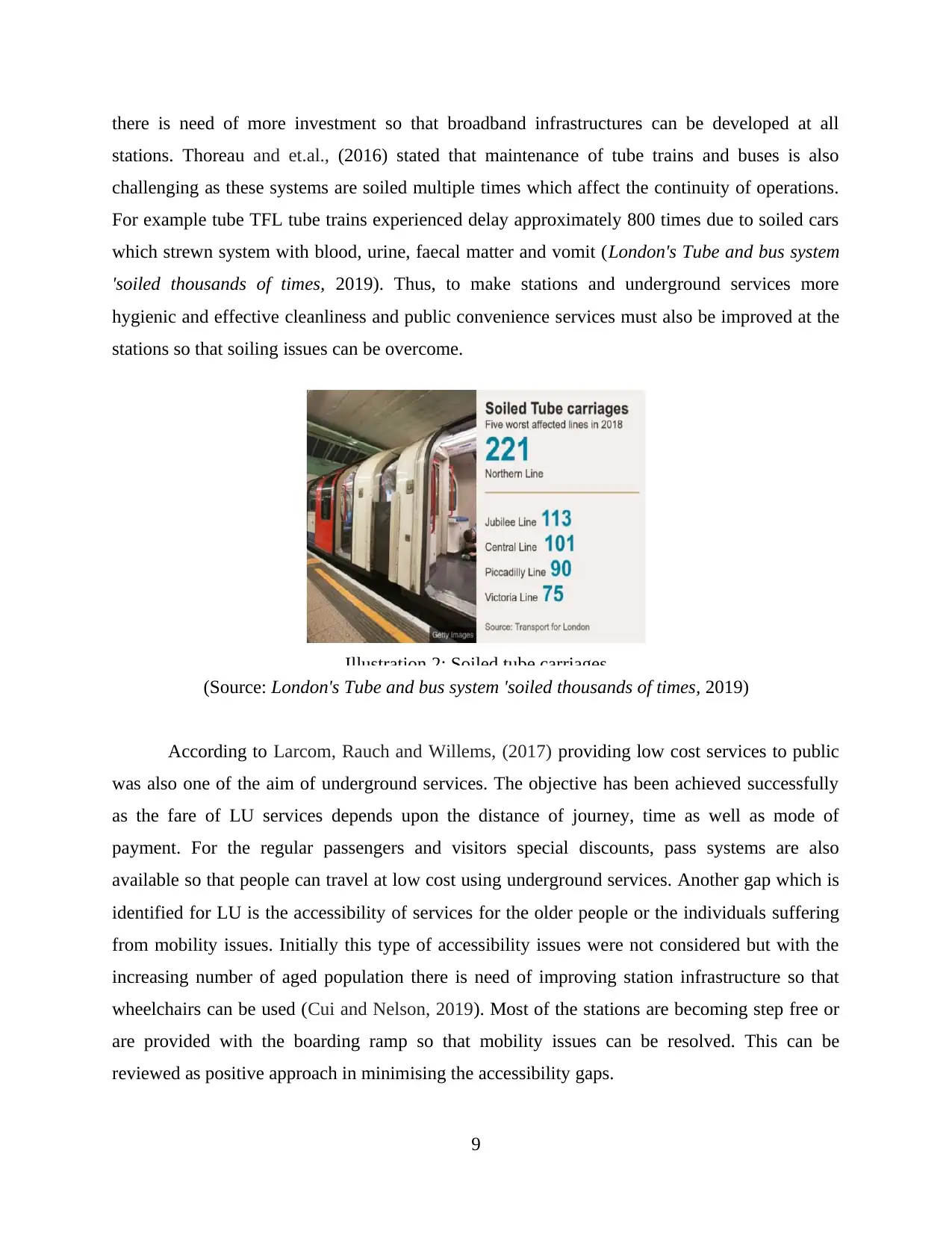
there is need of more investment so that broadband infrastructures can be developed at all
stations. Thoreau and et.al., (2016) stated that maintenance of tube trains and buses is also
challenging as these systems are soiled multiple times which affect the continuity of operations.
For example tube TFL tube trains experienced delay approximately 800 times due to soiled cars
which strewn system with blood, urine, faecal matter and vomit (London's Tube and bus system
'soiled thousands of times, 2019). Thus, to make stations and underground services more
hygienic and effective cleanliness and public convenience services must also be improved at the
stations so that soiling issues can be overcome.
(Source: London's Tube and bus system 'soiled thousands of times, 2019)
According to Larcom, Rauch and Willems, (2017) providing low cost services to public
was also one of the aim of underground services. The objective has been achieved successfully
as the fare of LU services depends upon the distance of journey, time as well as mode of
payment. For the regular passengers and visitors special discounts, pass systems are also
available so that people can travel at low cost using underground services. Another gap which is
identified for LU is the accessibility of services for the older people or the individuals suffering
from mobility issues. Initially this type of accessibility issues were not considered but with the
increasing number of aged population there is need of improving station infrastructure so that
wheelchairs can be used (Cui and Nelson, 2019). Most of the stations are becoming step free or
are provided with the boarding ramp so that mobility issues can be resolved. This can be
reviewed as positive approach in minimising the accessibility gaps.
9
Illustration 2: Soiled tube carriages
stations. Thoreau and et.al., (2016) stated that maintenance of tube trains and buses is also
challenging as these systems are soiled multiple times which affect the continuity of operations.
For example tube TFL tube trains experienced delay approximately 800 times due to soiled cars
which strewn system with blood, urine, faecal matter and vomit (London's Tube and bus system
'soiled thousands of times, 2019). Thus, to make stations and underground services more
hygienic and effective cleanliness and public convenience services must also be improved at the
stations so that soiling issues can be overcome.
(Source: London's Tube and bus system 'soiled thousands of times, 2019)
According to Larcom, Rauch and Willems, (2017) providing low cost services to public
was also one of the aim of underground services. The objective has been achieved successfully
as the fare of LU services depends upon the distance of journey, time as well as mode of
payment. For the regular passengers and visitors special discounts, pass systems are also
available so that people can travel at low cost using underground services. Another gap which is
identified for LU is the accessibility of services for the older people or the individuals suffering
from mobility issues. Initially this type of accessibility issues were not considered but with the
increasing number of aged population there is need of improving station infrastructure so that
wheelchairs can be used (Cui and Nelson, 2019). Most of the stations are becoming step free or
are provided with the boarding ramp so that mobility issues can be resolved. This can be
reviewed as positive approach in minimising the accessibility gaps.
9
Illustration 2: Soiled tube carriages
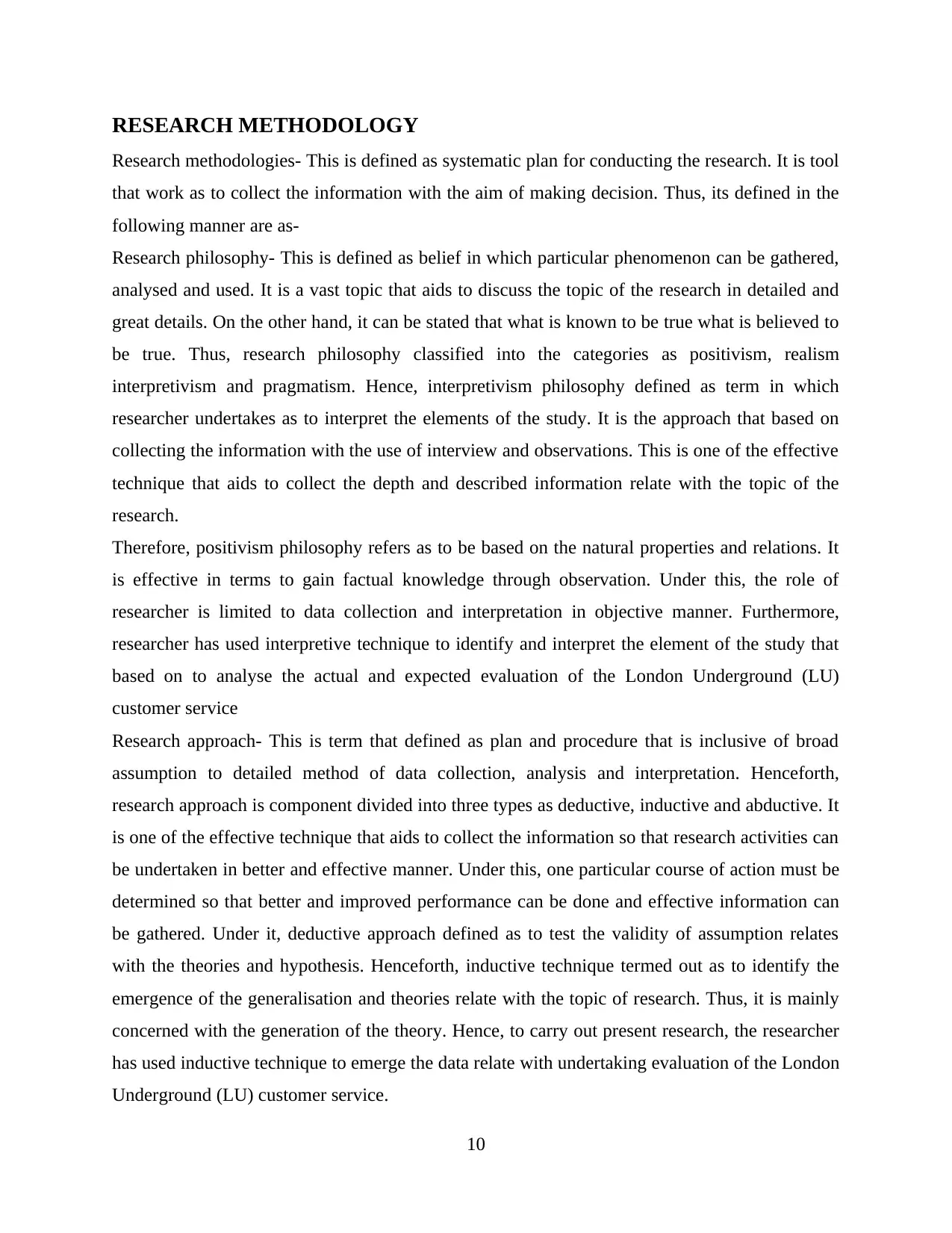
RESEARCH METHODOLOGY
Research methodologies- This is defined as systematic plan for conducting the research. It is tool
that work as to collect the information with the aim of making decision. Thus, its defined in the
following manner are as-
Research philosophy- This is defined as belief in which particular phenomenon can be gathered,
analysed and used. It is a vast topic that aids to discuss the topic of the research in detailed and
great details. On the other hand, it can be stated that what is known to be true what is believed to
be true. Thus, research philosophy classified into the categories as positivism, realism
interpretivism and pragmatism. Hence, interpretivism philosophy defined as term in which
researcher undertakes as to interpret the elements of the study. It is the approach that based on
collecting the information with the use of interview and observations. This is one of the effective
technique that aids to collect the depth and described information relate with the topic of the
research.
Therefore, positivism philosophy refers as to be based on the natural properties and relations. It
is effective in terms to gain factual knowledge through observation. Under this, the role of
researcher is limited to data collection and interpretation in objective manner. Furthermore,
researcher has used interpretive technique to identify and interpret the element of the study that
based on to analyse the actual and expected evaluation of the London Underground (LU)
customer service
Research approach- This is term that defined as plan and procedure that is inclusive of broad
assumption to detailed method of data collection, analysis and interpretation. Henceforth,
research approach is component divided into three types as deductive, inductive and abductive. It
is one of the effective technique that aids to collect the information so that research activities can
be undertaken in better and effective manner. Under this, one particular course of action must be
determined so that better and improved performance can be done and effective information can
be gathered. Under it, deductive approach defined as to test the validity of assumption relates
with the theories and hypothesis. Henceforth, inductive technique termed out as to identify the
emergence of the generalisation and theories relate with the topic of research. Thus, it is mainly
concerned with the generation of the theory. Hence, to carry out present research, the researcher
has used inductive technique to emerge the data relate with undertaking evaluation of the London
Underground (LU) customer service.
10
Research methodologies- This is defined as systematic plan for conducting the research. It is tool
that work as to collect the information with the aim of making decision. Thus, its defined in the
following manner are as-
Research philosophy- This is defined as belief in which particular phenomenon can be gathered,
analysed and used. It is a vast topic that aids to discuss the topic of the research in detailed and
great details. On the other hand, it can be stated that what is known to be true what is believed to
be true. Thus, research philosophy classified into the categories as positivism, realism
interpretivism and pragmatism. Hence, interpretivism philosophy defined as term in which
researcher undertakes as to interpret the elements of the study. It is the approach that based on
collecting the information with the use of interview and observations. This is one of the effective
technique that aids to collect the depth and described information relate with the topic of the
research.
Therefore, positivism philosophy refers as to be based on the natural properties and relations. It
is effective in terms to gain factual knowledge through observation. Under this, the role of
researcher is limited to data collection and interpretation in objective manner. Furthermore,
researcher has used interpretive technique to identify and interpret the element of the study that
based on to analyse the actual and expected evaluation of the London Underground (LU)
customer service
Research approach- This is term that defined as plan and procedure that is inclusive of broad
assumption to detailed method of data collection, analysis and interpretation. Henceforth,
research approach is component divided into three types as deductive, inductive and abductive. It
is one of the effective technique that aids to collect the information so that research activities can
be undertaken in better and effective manner. Under this, one particular course of action must be
determined so that better and improved performance can be done and effective information can
be gathered. Under it, deductive approach defined as to test the validity of assumption relates
with the theories and hypothesis. Henceforth, inductive technique termed out as to identify the
emergence of the generalisation and theories relate with the topic of research. Thus, it is mainly
concerned with the generation of the theory. Hence, to carry out present research, the researcher
has used inductive technique to emerge the data relate with undertaking evaluation of the London
Underground (LU) customer service.
10
⊘ This is a preview!⊘
Do you want full access?
Subscribe today to unlock all pages.

Trusted by 1+ million students worldwide
1 out of 38
Your All-in-One AI-Powered Toolkit for Academic Success.
+13062052269
info@desklib.com
Available 24*7 on WhatsApp / Email
![[object Object]](/_next/static/media/star-bottom.7253800d.svg)
Unlock your academic potential
Copyright © 2020–2025 A2Z Services. All Rights Reserved. Developed and managed by ZUCOL.